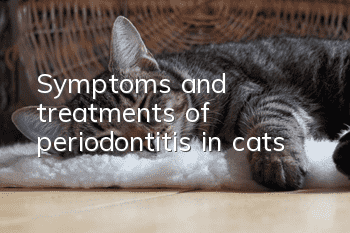Symptoms and treatments of periodontitis in cats

Periodontitis is a common oral disease in cats, with many causes. If the owner does not pay attention to cleaning the cat's oral cavity, it is easy to form dental calculus and cause periodontitis, so dental calculus is also one of the causes of the disease.
Causes of periodontitis in cats:
1. Mechanical stimulation occurs after dental calculus.
2. Caused by food accumulation or infection after tooth loss.
3. Improper feeding and management, lack of trace elements and vitamins in food.
4. Certain infectious diseases and chronic systemic diseases, such as calicivirus, diabetes, kidney disease, hyperthyroidism and genetic diseases.
Symptoms of periodontitis in cats
There are many oral diseases in cats, and periodontitis is one of the more common ones. Periodontitis refers to acute or chronic inflammation of the tissues around the teeth. This disease usually causes tooth roots to shrink, resulting in loose teeth and a foul odor in the mouth.
1. Usually there is bad breath and salivation. There is appetite but only soft food or liquid food can be eaten. The patient is afraid to chew food and has difficulty chewing. Occasionally, food touches the lesion and produces a cry of severe pain.
2. Sick cats often stop eating suddenly, suffer severe convulsions and spasms, and some turn in circles or fall down to resist inspection.
3. Molars are generally more common. In the early stage of the disease, if you gently touch the affected tooth with tweezers, there will often be obvious pain. When the tooth becomes loose, the pain will be relieved, and the tooth root will be congested and swollen. If pus is imminent, squeeze gently to drain the pus.
4. The affected cat resisted oral examination. During the oral examination, it was found that there was calculus attached to the teeth, the teeth were loose, the teeth were congested and swollen, and there was obvious pain when the affected teeth were touched with instruments.
Methods to prevent and treat periodontitis in cats
After a cat suffers from oral disease, it will have some impact on how much it eats, and periodontitis may cause the cat's teeth to become loose, which seriously affects the cat's quality of life. Therefore, when you find that your cat has oral problems, you must treat them as soon as possible.
1. The clinical symptoms of this disease can be significantly improved after oral cleaning and systemic application of antibiotics and corticosteroid therapy. Some cats can recover, but some cats are prone to relapse after stopping the medication and cannot be completely eradicated.
2. General anesthesia is required during treatment, and the head must be stabilized.
3. Thoroughly remove dental calculus, and necrotic teeth and teeth that have lost their function should be extracted.
4. Rinse the mouth with disinfectant, 0.1% potassium permanganate water or 3% boric acid water, and then apply 2% iodine glycerin or tin powder or ice boron powder. For patients with hyperplastic granuloma at the root of the tooth, 10% silver nitrate can be used.corrosion.
5. To control infection, you can use penicillin 50,000 units per kilogram of body weight and dexamethasone 0.5 mg per kilogram of body weight, mixed once for intramuscular injection, twice a day. Or use gentamicin 10,000 units per kilogram of body weight, ground Dexamethasone 0.5 mg per kilogram of body weight, mixed once for intramuscular injection, 2 times a day.
6. Supportive therapy. For cats with reduced appetite, glucose and compound saline should be infused intravenously, and oral vitamin B preparations should be given.
7. Give nutritious liquid food.
8. Daily feeding should ensure the cat’s nutritional balance and play a role in preventing periodontal disease.
9. Check regularly and eliminate tartar in time.
- A cat will die if it urinates for a few days
- Should you deworm yourself or go to a pet store?
- Are cat teasers harmful to cats?
- What should I do if my cat suffers from chronic gingivitis?
- Cat's nails are cracked with a thin layer
- Cats go crazy after eating mutton
- What does cat moss on a cat’s chin look like?
- Can cats reproduce after abdominal transmission is cured?
- What exactly is the sterilization shot for female cats?
- Can I still eat unopened cat food if it has expired?



